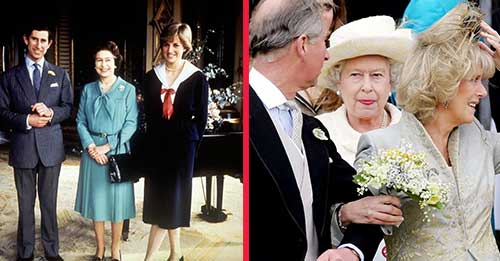The late Queen Elizabeth II did not appear to approve of her oldest son Charles’ relationship with his second wife, Camilla Parker Bowles.
Members of the royal family apparently did not think Camilla was a good fit for the then-king-to-be. The couple met in 1970 and dated for a while before Charles married Princess Diana and Camilla married Andrew Parker Bowles. However, following Diana’s death in 1997, both of them were divorced and desired to remarry. This was a problem for the couple’s marriage since they would have to submit to the Church of England, of which the Queen was the head. Historically, because the two were divorced, it was a definite no-no for the church. Rather, the couple married on April 9, 2005, in Windsor Guildhall.
Because the two were not permitted to marry in the Church of England, Queen Elizabeth and Prince Philip did not attend as a gesture of maintaining the COE’s beliefs. The Queen and Prince Philip later held a wedding celebration for the couple and even took part in a religious blessing at St George’s Chapel, indicating that the senior royals approved of the marriage.
The pair’s journey to blissfully ever after was not without its challenges. According to British investigative journalist Tom Bower, the Queen did not approve of her son’s remarriage to Camila. According to ET Canada, the book Rebel Prince: The Power, Passion, and Defiance of Prince Charles reported that the Queen, who was inebriated on “many martinis,” warned Charles that she would not tolerate his infidelity. She was also enraged with Camila for not allowing Charles and Diana’s marriage to recover. According to the book, the Queen even referred to Camilla as “that nasty lady,” adding, she wanted nothing to do with her.
The Queen also had a troubled connection with Charles’ first wife, Princess Diana, who died in 1997. According to The New York Post, royal writer Ingrid Seward stated in her book The Queen and Di that while the queen was “sensitive of Diana’s struggles,” she did not know how to aid Diana’s mental suffering when things were hard between her and Charles. “A footman reported, ‘The princess sobbed three times in a half hour while she was waiting to meet you,” Seward wrote. “I had her for an hour – and she sobbed incessantly,” the queen said. “There was a communication barrier between two very different generations,” Diana’s private secretary Patrick Jephson explained in the Channel 5 program Two Golden Queens. According to Jephson, “between two powerful ladies.” “There was a certain school of conventional royal thinking that Diana should cease being ridiculous.” The British monarchy was a representation of traditions and old-school ideals, and Diana’s vibrant personality and free spirit stirred more than a few feathers in the establishment.
When Princess Diana died, the Queen said she wanted to pay respect to Diana herself. She was a remarkable and brilliant human being. She never lost her ability to grin and laugh, or to inspire people with her love and generosity, in good or terrible circumstances. The queen appreciated and respected her for her energy and dedication to others, especially her children.
Share this with your friends by clicking below!





